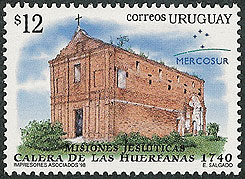Calera
de las Huérfanas, Colonia

URUGUAY, 1998, Mercosur issue, Scott 1728
Calera de Las Huérfanas was run by the Jesuits as an estancia in Colonia (in modern Uruguay) possibly since 1738. Its purpose was to support the Jesuit college in Belén and the Convent of San Telmo in Buenos Aires. When the Jesuits were expelled in 1767, the Spanish administration put Don Juan de San Martín, the father of the Argentine hero General José de San Martín, in charge of the estancia. Ten years later, the Sisters of Charity moved there from Buenos Aires and established a shelter for orphaned girls. Thus its present name, Estancia y Calera de Las Huérfanas. Uruguay and the other nations of Mercosur, the Latin American Common Market, agreed each to issued a stamp honoring the Jesuit missions.
Colegio Seminario
and the Church of the Sacred Heart, Montevideo

URUGUAY, 2005, the 125th anniversary of the Colegio Seminario
showing both the college and the domed church of the Sacred Heart parish entrusted to the Jesuits, Scott 2117-2118Construction of the Colegio Seminario in Montevideo, Uruguay began on December 16, 1878 and the Jesuits moved from their Cannelloni Street residence to the new school the following year. Its doors opened on February 20, 1880 and the first rector, Father Ramón Morel, SJ welcomed the first twelve students, all seminarians because there was not enough room for secular students until the following year. By 1891 the Church of the Sacred Heart had been built. In more recent times a grade school and high school have been added, and the institution now serves more than 1800 students. Over the last 125 years the school has lived up to its motto, Ut Serviam (That I Serve) as part of the international network of Jesuit educational institutions. The stamps are based on two old photographs of the school. The image of Saint Ignatius was based on the death mask of the saint, and was created by an alumnus of the school, the well-known national sculptor and painter, José Luis Zorrilla de San Martín.
